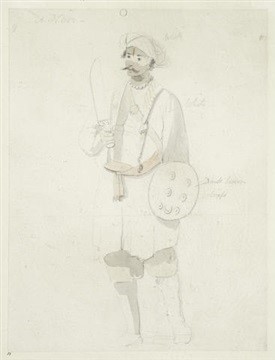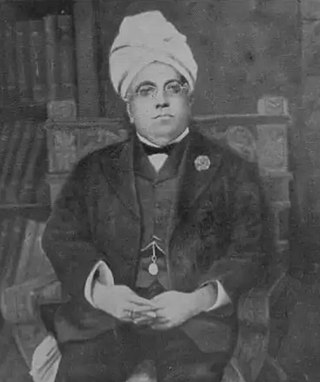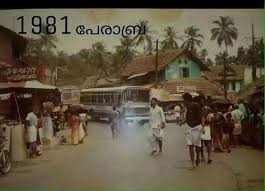Related Research Articles

Valluvanad was an independent chiefdom in present-day central Kerala that held power from the early 12th century to the end of the 18th century. Prior to that, and since the late 10th century, Valluvanad existed as an autonomous chiefdom within the kingdom of the Chera Perumals. The disintegration of the Chera Perumal kingdom in early 12th century led to the independence of the various autonomous chiefdoms of the kingdom, Valluvanad being one of them.

The Nair also known as Nayar, are a group of Indian Hindu castes, described by anthropologist Kathleen Gough as "not a unitary group but a named category of castes". The Nair include several castes and many subdivisions, not all of whom historically bore the name 'Nair'. These people lived, and continue to live, in the area which is now the Indian state of Kerala. Their internal caste behaviours and systems are markedly different between the people in the northern and southern sections of the area, although there is not very much reliable information on those inhabiting the north.

Anizham Thirunal Marthanda Varma was the founding monarch of the southern Indian Kingdom of Travancore from 1729 until his death in 1758. He was succeeded by Rama Varma (1758–98). While he was the heir to the throne, he suggested to his uncle the idea of forming an alliance with the Mughal Nawab of Carnatic. Rama Varma pledged allegiance to the Mughal empire and embraced the title of "Zamindar of Malabar". The feudatory status of Travancore persisted even during the era of Hyder Ali.

Kolattunādu (Kola Swarupam, as Kingdom of Cannanore in foreign accounts, Chirakkal (Chericul) in later times) was one of the four most powerful kingdoms on the Malabar Coast during the arrival of the Portuguese Armadas in India, along with Zamorin, the Kingdom of Cochin and Quilon. Kolattunādu had its capital at Ezhimala and was ruled by the Kolattiri royal family and roughly comprised the North Malabar region of Kerala state in India. Traditionally, Kolattunādu is described as the land lying between the Chandragiri river in the north and the Korappuzha river in the south. The Kolathunadu (Kannur) Kingdom at the peak of its power, reportedly extended from the Netravati River (Mangalore) in the north to Korapuzha (Kozhikode) in the south with the Arabian Sea on the west and Kodagu hills on the eastern boundary, also including the isolated islands of Lakshadweep in the Arabian Sea.
Azhvanchery Thamprakkal or Azhvanchery Samrāṭ is the title of the senior-most male member of the Nambudiri Brahmin feudal lords of Azhvanchery Mana in Athavanad, Kerala, South India. They had the right over Guruvayur, and were the titular head of all Nambudiri Brahmins of Kerala. The Lord of Azhvanchery based at Athavanad and the Lord of Kalpakanchery based at neighbouring Kalpakanchery were usually present at the coronation of a new Zamorin of Kozhikode. Kalpakanchery Thamprakkals were related to the Nambudiris of Panniyoor while Azhvanchery Thamprakkals to those of Chowwara.

Vengayil Kunhiraman Nayanar was a Malayali essayist and short story writer, and a prominent landlord of Malabar district.

The Ettuveetil Pillamar were Nair nobles from eight ruling Houses in erstwhile Travancore in present-day Kerala state, South India. They were associated with the Padmanabhaswamy temple in Thiruvananthapuram and the Ettara Yogam. Their power and wealth grew until Marthanda Varma (1706–1758), the last king of Venad and the first king of Travancore, defeated them in the 1730s.

Malayali Brahmins or Kerala Brahmins are the group of Brahmins from the Indian state of Kerala. These groups include the Nambudiri, and the Potti.

The Kavalappara is an princely Indian Nair tharavad or swaroopam, whose estates and powers vested in the matrilineally-mediated succession to and from each Kavalappara Nair, who headed the family and held the rank of Moopil Nair. In medieval Kerala, they served as part of the jenmi, or allodially landed nobility, and were sworn to the service of the rajas of the area, first that of Palghat and then later that of Cochin. Based at Kavalappara Desam in Karakkat, Valluvanada, their holdings extended to areas such as Kailiad and Panayur, ultimately compassing some 155,358 acres of jenmom estates, and ranking preeminent among the jenmimars of Malabar.

North Malabar refers to the geographic area of southwest India covering the state of Kerala's present day Kasaragod, Kannur, and Wayanad districts, and the taluks of Vatakara and Koyilandy in the Kozhikode District of Kerala and the entire Mahé Sub-Division of the Union Territory of Puducherry. Traditionally North Malabar has been defined as the northern portion of the erstwhile Malabar District which lies between Chandragiri River and Korapuzha River. The region between Netravathi River and Chandragiri River, which included the portions between Mangalore and Kasaragod, are also often included in the term North Malabar, as the Kumbla dynasty in the southernmost region of Tulu Nadu, had a mixed lineage of Malayali Nairs and Tuluva Brahmins.
Moopil Nair, also transliterated Mooppil and Muppil is an elite subgroup of the Nair caste. They were vazhunnors, naduvazhis and desavazhis of small feudal polities on the Malabar Coast, present-day Kerala state, South India, typically owing at least nominal allegiance to a superordinate Raja, despite frequently aggregating lands and political powers of sufficient scale so as to establish them as essentially autonomous monarchs in their own rights. Although Moopils frequently simply styled themselves as 'the' name of swaroopam/tharavadu Nair, virtually all were entitled to higher titular Nair rank, most saliently that of Nambiar, but also Nayanar and Mannadiyar, among others.
Madampi(equivalent to Lord in English) is an aristocratic title given to the uppermost subdivisions of Nairs in Kerala, by the Maharajahs of Travancore and Cochin. Usually, it was given in addition to the Pillai title. Madampis served as Jenmis or landlords during the pre-independence era. Their power was severely reduced after the Communist government passed the Land Reforms Ordinance. The title Madampi was also used in Cochin, to denote the 71 Nayar chiefs who ruled under the Maharajah of Cochin. A few Nambuthiri landlord families, most notable of whom being those in Vanjipuzha and Makilanjeri, were also given the Madampi title. In Cochin, the Madampis had their own armies, but seldom numbered more than 100. Their power was only a little bit higher than that of the Desavazhis. Madampis supplied chieftains along with soldiers in times of war to the King.

The Malabar rebellion of 1921 started as a resistance against the British colonial rule in certain places in the southern part of old Malabar district of present-day Kerala. The popular uprising was also against the prevailing feudal system controlled by elite Hindus. During the rebellion, thousands of Hindus were murdered and forcibly converted to Islam.

Pillai, meaning Prince, is a title of nobility which can either refer to a ruling chief, members of the nobility, or junior princes of the royal family historically ranked immediately below the king. The oldest lineages of Pillais include not only Kshatriyas but also brahmins who took up the sword. From the early modern period, the title also came to be bestowed upon Savarna subjects by the King of Travancore for services military or political, most of whom were of Nair origin.
Nambidi is a caste of Kerala, India. The form a part of the Ambalavasi community. They are considered to be Malayali Brahmins and to have originated when a section of the Nambudiris was degraded. They also have the same rights and rituals of nambudiri's. The nambidi ladies are usually called Mandals / Atholammas used to wear the cheruthalis and are similar to Antharjanams. The nambidi's also had great economic and Societic importance and have the same grade of Nambudiris in the Society. They have no right to do Poojas in temples. Nambidis are divided into two: the ones who wear the sacred thread and perform the Upanayanam and the ones who do not. The former are Nambudiris who were degraded to the Lower status since their ancestors had committed a heinous act by murdering a ruler of Kerala. On their return the other Nambudiris welcomed them but they refused to seat themselves with the other Brahmins owing to the sin they committed and instead sat on the steps of the hall. They came to be known as Nom Padimels or those on the steps and this term was later corrupted into Nambidi. The latter are Nairs who were assigned the Nambidi title. Namboodiris will Join with nambidi's in all their functions and rituals.

M. R. Ry. Chempakaraman Padmanabhan Kesava Pillai of Kandamath, Pillai of Kandamath (1830–1924), was an Indian Zamindar, one of the jenmis of Travancore and a member of the Sree Moolam Popular Assembly.
Pillai of Pallichal is a title of the order of nobility in Travancore. The holders of the title held the lands of the Padmanabhaswamy Temple. The most notorious holder of the title, whose given name is disputed, was executed by King Marthanda Varma in the 1750s and relations banished.

The KoothaliMoopil Nair or Moothavar, most commonly known as the Koothali Nair and styled Vallabhan Chathan, additionally known as the Koothali Payyormala Nayar and as Vazhunnavar, historically held and controlled an eponymous principality and sthanam of North Malabar, with his hereditary seat in Koothali. Towns and lands subject to the Koothali Moothavar's rule traditionally included Perambra, Changaroth, Cheruvannur, Kuttiady, and adjacent regions, including Kottathara. The Koothali Nair was traditionally one of Malabar's most prominent Naduvazhis, a Moopil Nair and Vazhunnavar, as well as a major Jenmimar, and held the Nair caste rank of Nambiar or Samanta, and the family style of swaroopam.
References
- ↑ Panikkar, Kavalam Madhava (July–December 1918). "Some Aspects of Nayar Life". Journal of the Royal Anthropological Institute. 48: 257–258.
- ↑ Shaji, A. (December 2017). Politicization of Caste Relations in a Princely State (Communal Politics in Modern Travancore 1891-1947). Zorba Books. ISBN 9789387456006.
- ↑ Karat, Prakash (1977). "Organized Struggles of Malabar Peasantry, 1934-1940". Social Scientist. 5 (8): 3–17. doi:10.2307/3516560. JSTOR 3516560.
- ↑ Nair, Adoor K.K. Ramachandran (January 1986). "Slavery in Kerala". Mittal Publications, New Delhi.
- ↑ Modern Kerala: Studies in Social and Agrarian Relations. Mittal Publications. 11 September 1988. ISBN 9788170990949.
- ↑ Shungoonny Menon, P. (1998). History of Travancore from the earliest times (2nd AES repr. [d.Ausg.] Madras, Higginbotham, 1878 ed.). New Delhi: Asian Educational Services. ISBN 978-81-206-0169-7.
- ↑ See Further Notes on Poonjar Cheiftains Article accessed at http://shodhganga.inflibnet.ac.in/bitstream/10603/72849/14/14_appendix%201.pdf
- ↑ Agrarian change and economic consequences: land tenures in Kerala, 1850–1960 By T. C. Varghese
- ↑ India: social structure By Mysore Narasimhachar Srinivas p.15
- ↑ "Kerala high court asks govt to pay pension to 'jenmis'". The Times of India . 29 June 2013.
- ↑ "Post-independence India – Google Books" . Retrieved 9 October 2023.
- ↑ Education, Kerala (India) Department of; Menon, A. Sreedhara (9 October 1962). "Kerala District Gazetteers: Cannanore". Superintendent of Government Presses. Retrieved 9 October 2023– via Google Books.